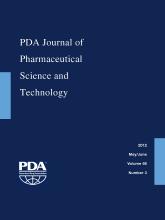Abstract
Parallelism is a prerequisite for the determination of relative potency in bioactivity assays. It involves the testing of similarity between a pair of dose-response curves of reference standard and test sample. The evaluation of parallelism is a requirement listed by both the United States Pharmacopeia (USP) and European Pharmacopeia (EP). The revised USP Chapters 〈1032〉 and 〈1034〉 suggest testing parallelism using an equivalence method. However, implementation of this method can be challenging for laboratories that lack experience in statistical analysis and software development. In this paper we present a customized assay analysis template that is developed based on a fully good manufacturing practice (GMP)-compliant software package. The template allows for automation of the USP-recommended equivalence parallelism testing method for 4PLmodel in bioassays. It makes the implementation of the USP guidance both practical and feasible. Use of the analysis template is illustrated through a practical example.
LAY ABSTRACT: Parallelism is a prerequisite for the determination of relative potency in bioactivity assays. It involves the testing of similarity between a pair of dose-response curves of reference standard and test sample. The evaluation of parallelism is a requirement listed by both the United States Pharmacopeia (USP) and European Pharmacopeia (EP). The revised USP Chapters 〈1032〉 and 〈1034〉 suggest testing parallelism using an equivalence method. However, implementation of this method can be challenging for laboratories that lack experience in statistical analysis and software development. In this paper we present a customized assay analysis template that is developed based on a fully good manufacturing practice (GMP)-compliant software package. The template allows for automation of the USP-recommended equivalence parallelism testing method for 4-parameter logistic model in bioassays. It makes the implementation of the USP guidance both practical and feasible. Use of the analysis template is illustrated through a practical example.
- © PDA, Inc. 2012
PDA members receive access to all articles published in the current year and previous volume year. Institutional subscribers received access to all content. Log in below to receive access to this article if you are either of these.
If you are neither or you are a PDA member trying to access an article outside of your membership license, then you must purchase access to this article (below). If you do not have a username or password for JPST, you will be required to create an account prior to purchasing.
Full issue PDFs are for PDA members only.
Note to pda.org users
The PDA and PDA bookstore websites (www.pda.org and www.pda.org/bookstore) are separate websites from the PDA JPST website. When you first join PDA, your initial UserID and Password are sent to HighWirePress to create your PDA JPST account. Subsequent UserrID and Password changes required at the PDA websites will not pass on to PDA JPST and vice versa. If you forget your PDA JPST UserID and/or Password, you can request help to retrieve UserID and reset Password below.






